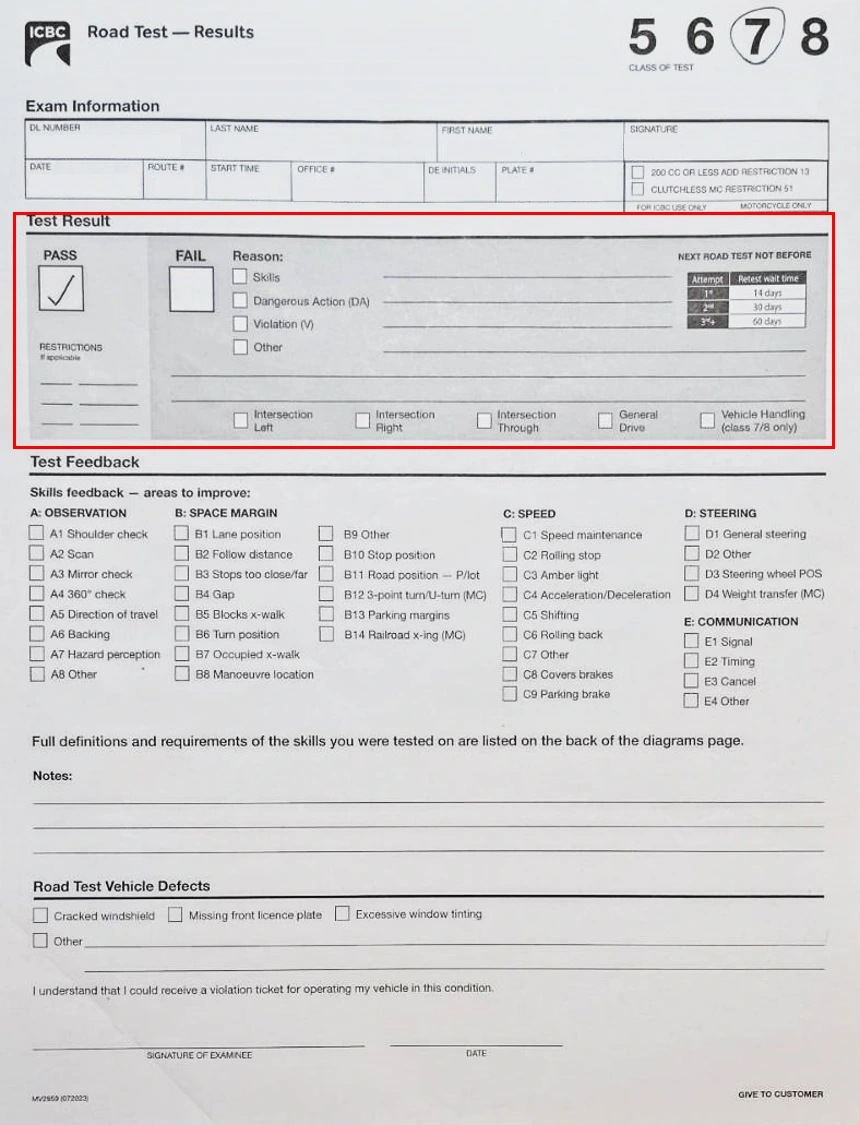Understanding Class 5/7 Road Test Result Sheet
The chart below displays the ICBC Road Test Result Sheet. In this article, we will explain the criteria for determining the road test result by analyzing the contents of the sheet, and provide passing key points for readers’ reference.

The result of the road test will be shown in the red box in the above figure. If the road test is passed, the PASS box will be marked. If the judgment fails, it will be marked in the FAIL box (as shown in the example below). The reason for the failure will be marked in the small square in the blue box in the figure below, and the small square in the yellow box at the bottom of the figure below will be marked with the section in which it occurred. The description will be provided in the writing column in the figure.

The reasons for failing a road test
ICBC categorizes four types of reasons for failing a road test: skills, dangerous action, violation, and others. The specifics are as follows:
Skills (Failure to meet skill standards)
ICBC categorizes driving skills into 5 major categories: A. Observation, B. Space Margin, C. Speed, D. Steering, and E. Communication, and is subdivided into 27 assessment items. Generally speaking, the examiner will mark an item if the candidate fails to perform it correctly twice. This mark will be used as a basis for judgment and reference for the candidate’s subsequent improvement, as shown in the picture above.

To pass the driving skill test, the examinee must meet the minimum requirements of the 27 assessment items listed above. This means that the examinee must understand the requirements of each item and perform most of them correctly. During the road test, if the examiner points out that a certain item was missed or failed, you should remain calm and continue to complete the road test. Occasional mistakes are acceptable if an item is missed or failed, as long as there are not many items and each item has no more than two errors. However, a series of multiple errors in a single item is not acceptable. Some examiners may kindly remind you of a mistake the first time, so it is important to be especially careful not to make the same mistake continuously. Additionally, if you make a serious mistake on a single item. For example, if you exceed the speed limit of 30 kilometers per hour in a school zone (C1 speed maintenance), the examiner may consider it a violation of the law and fail you, even if it only happens once during the road test.
However, excessive errors can lead to the examiner making subjective decisions and potentially failing the test. Additionally, the current road test time has been shortened from 45 to 35 minutes, making it even more important to minimize errors. Therefore, it is recommended to avoid errors as much as possible.
Dangerous Action (DA)
During a road test, if an examinee performs an action that could result in a collision or loss of control of the vehicle, and requires the examiner to intervene verbally or physically, or causes other vehicles or pedestrians to slow down or dodge to avoid a collision, it will be considered a failure. Examples of such action include : Making a left turn or lane change with an insufficient safe gap, and failure to watch for or yield to pedestrians. Even if this occurs only once, the examiner may consider it a dangerous action and fail the road test.
Violation (V)
Where observed behavior exceeds the range in the applicable criteria and is typically a ticketable offence.
e.g.: Running a red light, failing to stop at a stop sign or speeding in a school zone or sports field, even if it
was only once, the examiner may decide that you have failed the road test if he/she deems the
violation valid.
Others
- Inability to operate equipment once test has begun. e.g.: Do not know how to turn on wipers when it rains、
Don’t know how to get rid of foggy windows. - Unwilling or unable to perform manoeuvre. e.g.: if the examiner requests a three-point turnaround and the
examinee is unsure how to perform - Hitting objects, driving over curbs/sidewalks.
If any of the situations described above occur during the road test, the examiner may determine that the road test has not been passed.
The key points for passing the road test :
- Practice enough to avoid making many errors in the listed driving skills. Do not make more than two errors in the same item or any serious errors.
- Do not perform dangerous actions, such as failing to notice or yield to pedestrians, making left/right turns or changing lanes without a safe gap.
- Do not run red lights, fail to stop at stop signs, speed in school zones or sports areas, or commit any other violations。
- Do not hit objects or drive over the curb onto the sidewalk.
- To ensure proper operation of the test vehicle, it is important to become familiar with its various devices. We recommend practicing driving in rainy weather at least once.
The above content aims to provide a comprehensive understanding of the ICBC road test and preparation points. If you have any questions, please do not hesitate to contact us.
